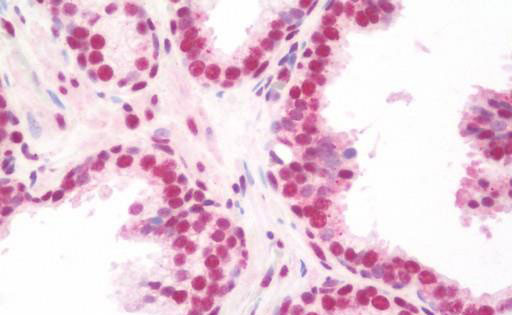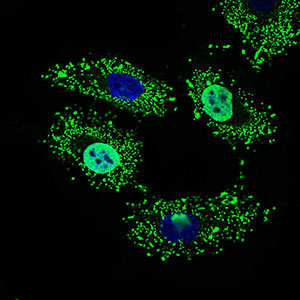NELFA / WHSC2 Antibody (aa280-511, clone 6B11H8)
Mouse Monoclonal Antibody
- SPECIFICATION
- CITATIONS
- PROTOCOLS
- BACKGROUND

Application
| WB, IHC-P, IF, ICC, E, FC |
|---|---|
| Primary Accession | Q9H3P2 |
| Reactivity | Human, Rat |
| Host | Mouse |
| Clonality | Monoclonal |
| Clone Names | 6B11H8 |
| Calculated MW | 57kDa |
| Dilution | ELISA (1:10000), Flo (1:200-1:400), ICC (1:200-1:1000), IHC-P (10 µg/ml), WB (1:500-1:2000) |
| Gene ID | 7469 |
|---|---|
| Other Names | Negative elongation factor A, NELF-A, Wolf-Hirschhorn syndrome candidate 2 protein, NELFA, WHSC2 |
| Target/Specificity | Human WHSC2 |
| Reconstitution & Storage | Short term +4°C; Long term -20°C |
| Precautions | NELFA / WHSC2 Antibody (aa280-511, clone 6B11H8) is for research use only and not for use in diagnostic or therapeutic procedures. |
| Name | NELFA |
|---|---|
| Synonyms | WHSC2 |
| Function | Essential component of the NELF complex, a complex that negatively regulates the elongation of transcription by RNA polymerase II. The NELF complex, which acts via an association with the DSIF complex and causes transcriptional pausing, is counteracted by the P- TEFb kinase complex. |
| Cellular Location | Nucleus. |
| Tissue Location | Ubiquitous. Expressed in heart, brain, placenta, liver, skeletal muscle, kidney and pancreas. Expressed at lower level in adult lung. Expressed in fetal brain, lung, liver and kidney |

Thousands of laboratories across the world have published research that depended on the performance of antibodies from Abcepta to advance their research. Check out links to articles that cite our products in major peer-reviewed journals, organized by research category.
info@abcepta.com, and receive a free "I Love Antibodies" mug.
Provided below are standard protocols that you may find useful for product applications.
Background
Essential component of the NELF complex, a complex that negatively regulates the elongation of transcription by RNA polymerase II. The NELF complex, which acts via an association with the DSIF complex and causes transcriptional pausing, is counteracted by the P-TEFb kinase complex. Probably required to interact with the RNA polymerase II complex.
References
Wright T.J.,et al.Genomics 59:203-212(1999).
Ito M.,et al.Cancer Res. 61:2038-2046(2001).
Mei G.,et al.Submitted (FEB-1999) to the EMBL/GenBank/DDBJ databases.
Ota T.,et al.Nat. Genet. 36:40-45(2004).
Hillier L.W.,et al.Nature 434:724-731(2005).
If you have used an Abcepta product and would like to share how it has performed, please click on the "Submit Review" button and provide the requested information. Our staff will examine and post your review and contact you if needed.
If you have any additional inquiries please email technical services at tech@abcepta.com.













 Foundational characteristics of cancer include proliferation, angiogenesis, migration, evasion of apoptosis, and cellular immortality. Find key markers for these cellular processes and antibodies to detect them.
Foundational characteristics of cancer include proliferation, angiogenesis, migration, evasion of apoptosis, and cellular immortality. Find key markers for these cellular processes and antibodies to detect them. The SUMOplot™ Analysis Program predicts and scores sumoylation sites in your protein. SUMOylation is a post-translational modification involved in various cellular processes, such as nuclear-cytosolic transport, transcriptional regulation, apoptosis, protein stability, response to stress, and progression through the cell cycle.
The SUMOplot™ Analysis Program predicts and scores sumoylation sites in your protein. SUMOylation is a post-translational modification involved in various cellular processes, such as nuclear-cytosolic transport, transcriptional regulation, apoptosis, protein stability, response to stress, and progression through the cell cycle. The Autophagy Receptor Motif Plotter predicts and scores autophagy receptor binding sites in your protein. Identifying proteins connected to this pathway is critical to understanding the role of autophagy in physiological as well as pathological processes such as development, differentiation, neurodegenerative diseases, stress, infection, and cancer.
The Autophagy Receptor Motif Plotter predicts and scores autophagy receptor binding sites in your protein. Identifying proteins connected to this pathway is critical to understanding the role of autophagy in physiological as well as pathological processes such as development, differentiation, neurodegenerative diseases, stress, infection, and cancer.




